Literature Review: Young People and Aged Care Integration Issues
VerifiedAdded on 2021/02/20
|7
|2232
|30
Literature Review
AI Summary
This literature review examines the complex topic of integrating young people, particularly those with brain injuries and ailments, into aged care facilities. It explores the potential benefits, such as improved treatment accuracy and time savings for healthcare professionals, as well as the potential drawbacks, including the lack of specialized care and the risk of isolation for younger residents. The review draws on various sources, including journal articles and online publications, to analyze the perspectives of care professionals, patients, and researchers. The review highlights arguments both for and against this practice, examining the challenges of providing appropriate care, the need for specialized facilities and staff training, and the importance of considering the unique needs of both young and older individuals in these settings. Ultimately, the review considers the current Australian context and the need for policy changes and innovative solutions to meet the needs of younger people with disabilities residing in aged care facilities, advocating for purpose-built accommodations and comprehensive care services.

Literature Review
Paraphrase This Document
Need a fresh take? Get an instant paraphrase of this document with our AI Paraphraser
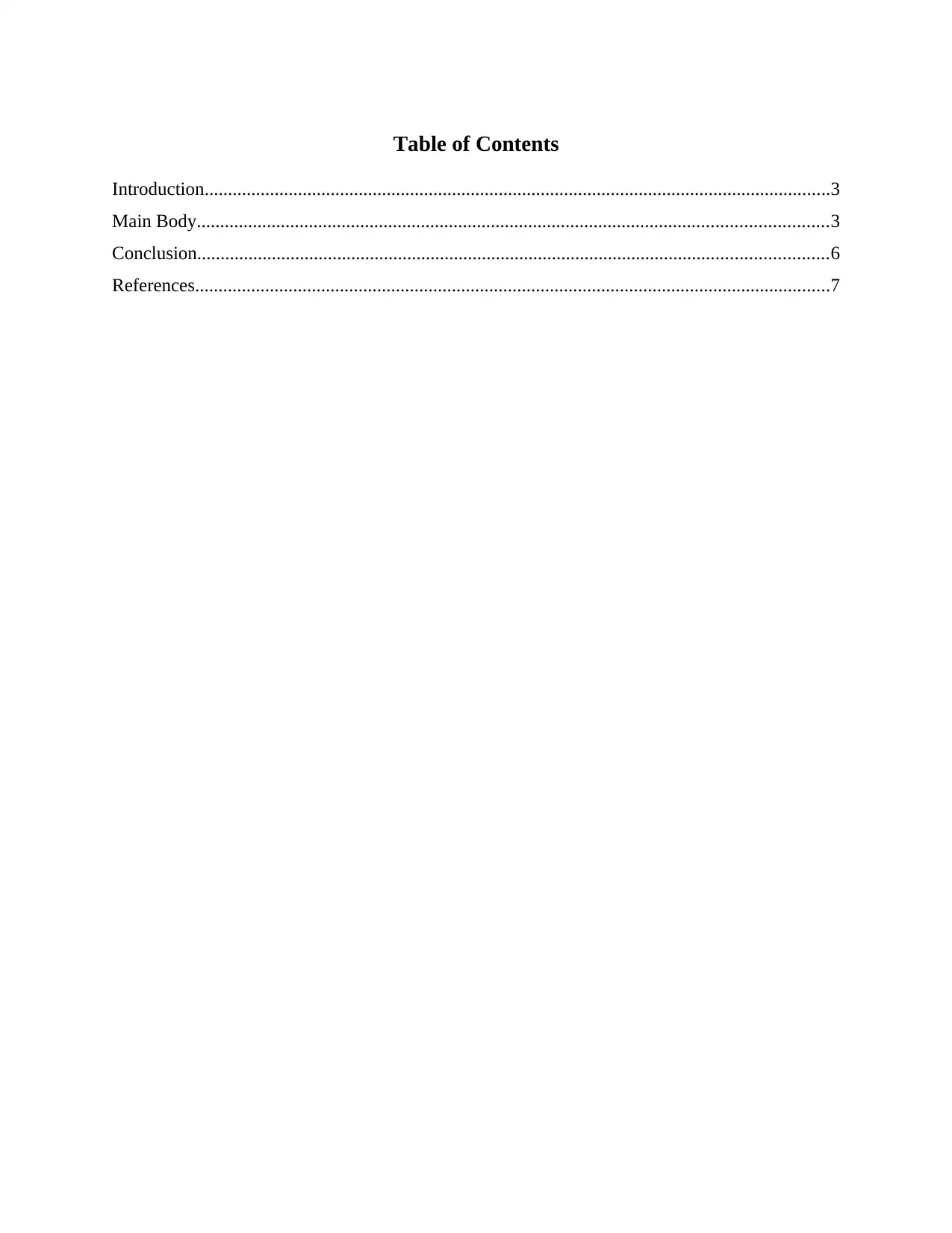
Table of Contents
Introduction......................................................................................................................................3
Main Body.......................................................................................................................................3
Conclusion.......................................................................................................................................6
References........................................................................................................................................7
Introduction......................................................................................................................................3
Main Body.......................................................................................................................................3
Conclusion.......................................................................................................................................6
References........................................................................................................................................7
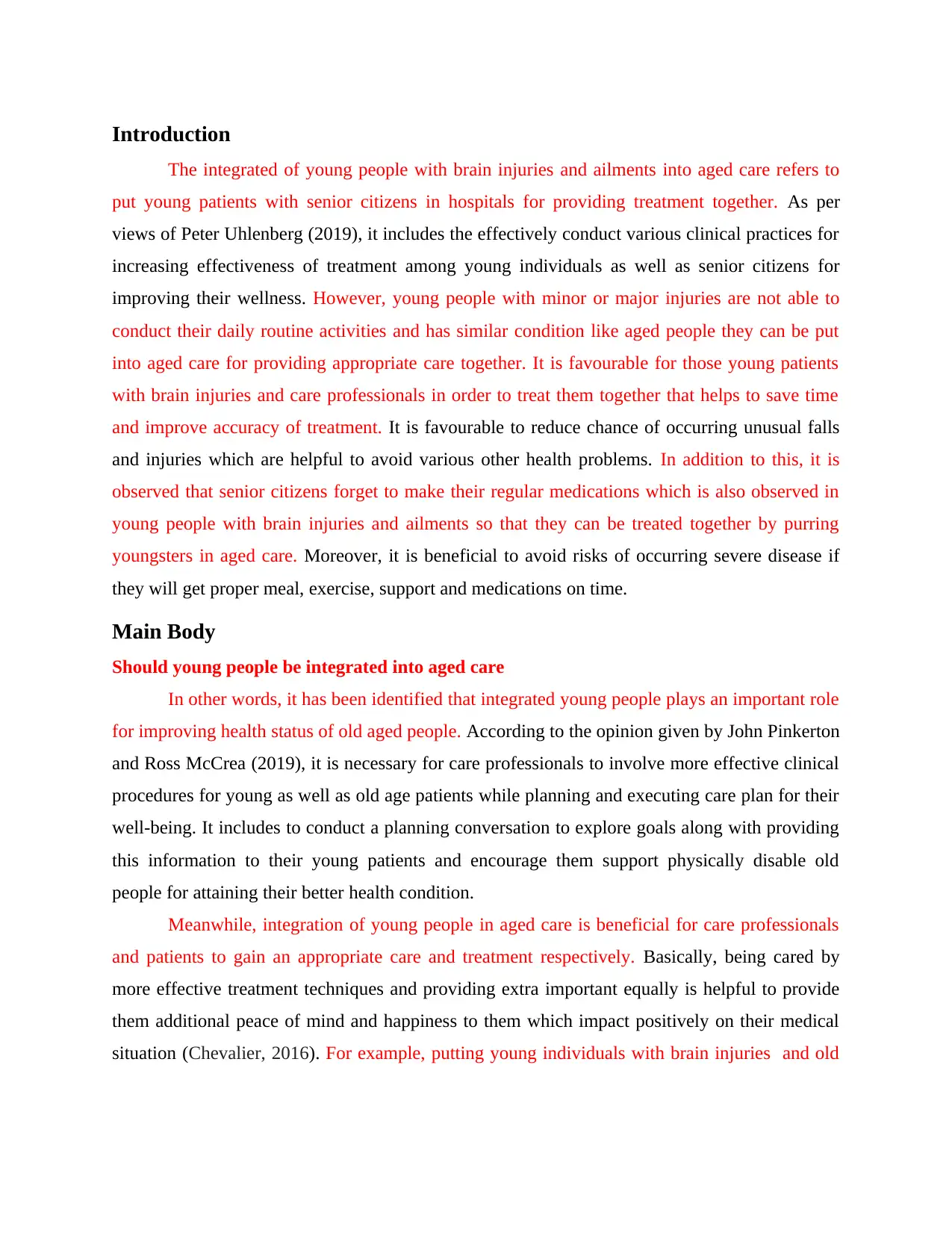
Introduction
The integrated of young people with brain injuries and ailments into aged care refers to
put young patients with senior citizens in hospitals for providing treatment together. As per
views of Peter Uhlenberg (2019), it includes the effectively conduct various clinical practices for
increasing effectiveness of treatment among young individuals as well as senior citizens for
improving their wellness. However, young people with minor or major injuries are not able to
conduct their daily routine activities and has similar condition like aged people they can be put
into aged care for providing appropriate care together. It is favourable for those young patients
with brain injuries and care professionals in order to treat them together that helps to save time
and improve accuracy of treatment. It is favourable to reduce chance of occurring unusual falls
and injuries which are helpful to avoid various other health problems. In addition to this, it is
observed that senior citizens forget to make their regular medications which is also observed in
young people with brain injuries and ailments so that they can be treated together by purring
youngsters in aged care. Moreover, it is beneficial to avoid risks of occurring severe disease if
they will get proper meal, exercise, support and medications on time.
Main Body
Should young people be integrated into aged care
In other words, it has been identified that integrated young people plays an important role
for improving health status of old aged people. According to the opinion given by John Pinkerton
and Ross McCrea (2019), it is necessary for care professionals to involve more effective clinical
procedures for young as well as old age patients while planning and executing care plan for their
well-being. It includes to conduct a planning conversation to explore goals along with providing
this information to their young patients and encourage them support physically disable old
people for attaining their better health condition.
Meanwhile, integration of young people in aged care is beneficial for care professionals
and patients to gain an appropriate care and treatment respectively. Basically, being cared by
more effective treatment techniques and providing extra important equally is helpful to provide
them additional peace of mind and happiness to them which impact positively on their medical
situation (Chevalier, 2016). For example, putting young individuals with brain injuries and old
The integrated of young people with brain injuries and ailments into aged care refers to
put young patients with senior citizens in hospitals for providing treatment together. As per
views of Peter Uhlenberg (2019), it includes the effectively conduct various clinical practices for
increasing effectiveness of treatment among young individuals as well as senior citizens for
improving their wellness. However, young people with minor or major injuries are not able to
conduct their daily routine activities and has similar condition like aged people they can be put
into aged care for providing appropriate care together. It is favourable for those young patients
with brain injuries and care professionals in order to treat them together that helps to save time
and improve accuracy of treatment. It is favourable to reduce chance of occurring unusual falls
and injuries which are helpful to avoid various other health problems. In addition to this, it is
observed that senior citizens forget to make their regular medications which is also observed in
young people with brain injuries and ailments so that they can be treated together by purring
youngsters in aged care. Moreover, it is beneficial to avoid risks of occurring severe disease if
they will get proper meal, exercise, support and medications on time.
Main Body
Should young people be integrated into aged care
In other words, it has been identified that integrated young people plays an important role
for improving health status of old aged people. According to the opinion given by John Pinkerton
and Ross McCrea (2019), it is necessary for care professionals to involve more effective clinical
procedures for young as well as old age patients while planning and executing care plan for their
well-being. It includes to conduct a planning conversation to explore goals along with providing
this information to their young patients and encourage them support physically disable old
people for attaining their better health condition.
Meanwhile, integration of young people in aged care is beneficial for care professionals
and patients to gain an appropriate care and treatment respectively. Basically, being cared by
more effective treatment techniques and providing extra important equally is helpful to provide
them additional peace of mind and happiness to them which impact positively on their medical
situation (Chevalier, 2016). For example, putting young individuals with brain injuries and old
⊘ This is a preview!⊘
Do you want full access?
Subscribe today to unlock all pages.

Trusted by 1+ million students worldwide
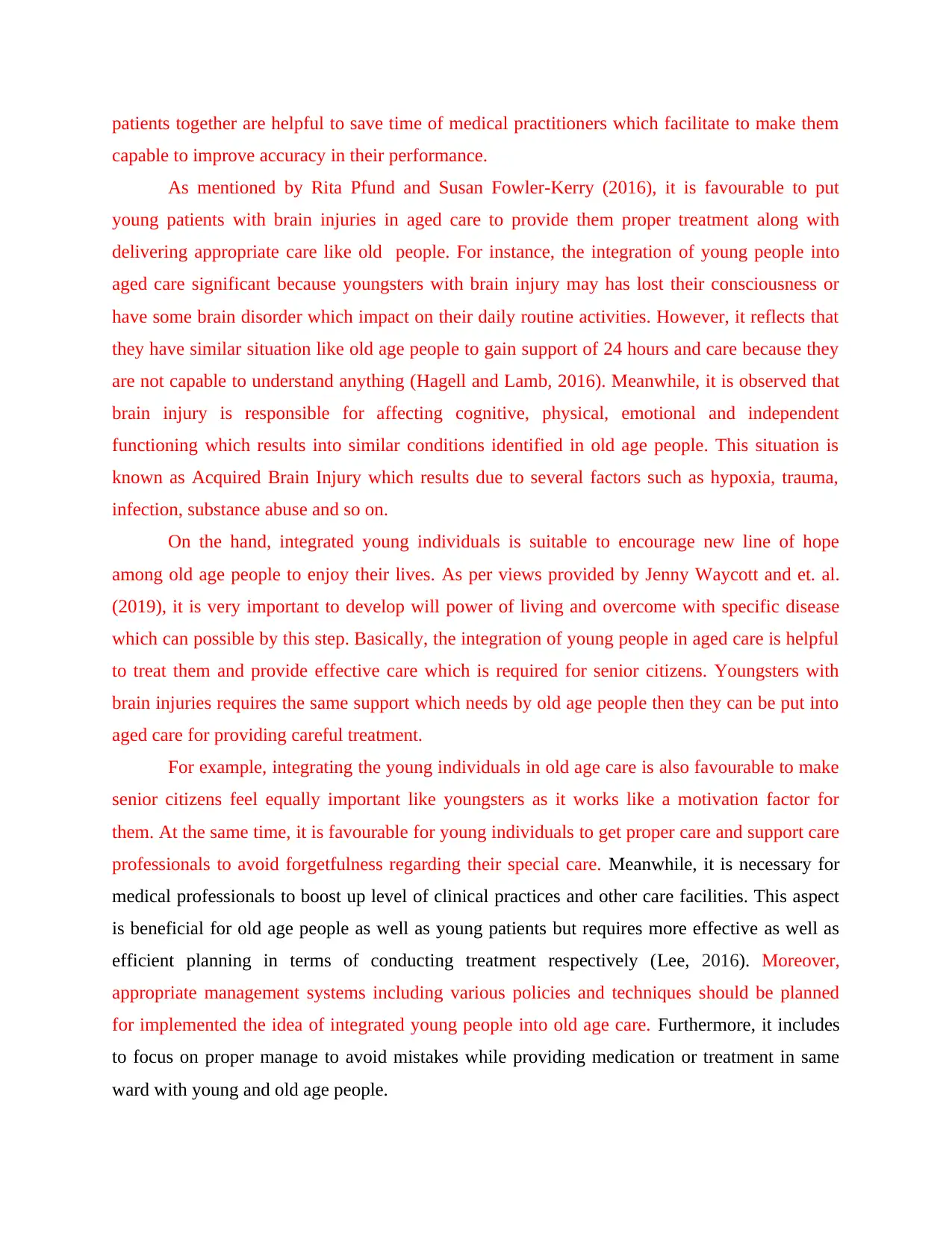
patients together are helpful to save time of medical practitioners which facilitate to make them
capable to improve accuracy in their performance.
As mentioned by Rita Pfund and Susan Fowler-Kerry (2016), it is favourable to put
young patients with brain injuries in aged care to provide them proper treatment along with
delivering appropriate care like old people. For instance, the integration of young people into
aged care significant because youngsters with brain injury may has lost their consciousness or
have some brain disorder which impact on their daily routine activities. However, it reflects that
they have similar situation like old age people to gain support of 24 hours and care because they
are not capable to understand anything (Hagell and Lamb, 2016). Meanwhile, it is observed that
brain injury is responsible for affecting cognitive, physical, emotional and independent
functioning which results into similar conditions identified in old age people. This situation is
known as Acquired Brain Injury which results due to several factors such as hypoxia, trauma,
infection, substance abuse and so on.
On the hand, integrated young individuals is suitable to encourage new line of hope
among old age people to enjoy their lives. As per views provided by Jenny Waycott and et. al.
(2019), it is very important to develop will power of living and overcome with specific disease
which can possible by this step. Basically, the integration of young people in aged care is helpful
to treat them and provide effective care which is required for senior citizens. Youngsters with
brain injuries requires the same support which needs by old age people then they can be put into
aged care for providing careful treatment.
For example, integrating the young individuals in old age care is also favourable to make
senior citizens feel equally important like youngsters as it works like a motivation factor for
them. At the same time, it is favourable for young individuals to get proper care and support care
professionals to avoid forgetfulness regarding their special care. Meanwhile, it is necessary for
medical professionals to boost up level of clinical practices and other care facilities. This aspect
is beneficial for old age people as well as young patients but requires more effective as well as
efficient planning in terms of conducting treatment respectively (Lee, 2016). Moreover,
appropriate management systems including various policies and techniques should be planned
for implemented the idea of integrated young people into old age care. Furthermore, it includes
to focus on proper manage to avoid mistakes while providing medication or treatment in same
ward with young and old age people.
capable to improve accuracy in their performance.
As mentioned by Rita Pfund and Susan Fowler-Kerry (2016), it is favourable to put
young patients with brain injuries in aged care to provide them proper treatment along with
delivering appropriate care like old people. For instance, the integration of young people into
aged care significant because youngsters with brain injury may has lost their consciousness or
have some brain disorder which impact on their daily routine activities. However, it reflects that
they have similar situation like old age people to gain support of 24 hours and care because they
are not capable to understand anything (Hagell and Lamb, 2016). Meanwhile, it is observed that
brain injury is responsible for affecting cognitive, physical, emotional and independent
functioning which results into similar conditions identified in old age people. This situation is
known as Acquired Brain Injury which results due to several factors such as hypoxia, trauma,
infection, substance abuse and so on.
On the hand, integrated young individuals is suitable to encourage new line of hope
among old age people to enjoy their lives. As per views provided by Jenny Waycott and et. al.
(2019), it is very important to develop will power of living and overcome with specific disease
which can possible by this step. Basically, the integration of young people in aged care is helpful
to treat them and provide effective care which is required for senior citizens. Youngsters with
brain injuries requires the same support which needs by old age people then they can be put into
aged care for providing careful treatment.
For example, integrating the young individuals in old age care is also favourable to make
senior citizens feel equally important like youngsters as it works like a motivation factor for
them. At the same time, it is favourable for young individuals to get proper care and support care
professionals to avoid forgetfulness regarding their special care. Meanwhile, it is necessary for
medical professionals to boost up level of clinical practices and other care facilities. This aspect
is beneficial for old age people as well as young patients but requires more effective as well as
efficient planning in terms of conducting treatment respectively (Lee, 2016). Moreover,
appropriate management systems including various policies and techniques should be planned
for implemented the idea of integrated young people into old age care. Furthermore, it includes
to focus on proper manage to avoid mistakes while providing medication or treatment in same
ward with young and old age people.
Paraphrase This Document
Need a fresh take? Get an instant paraphrase of this document with our AI Paraphraser
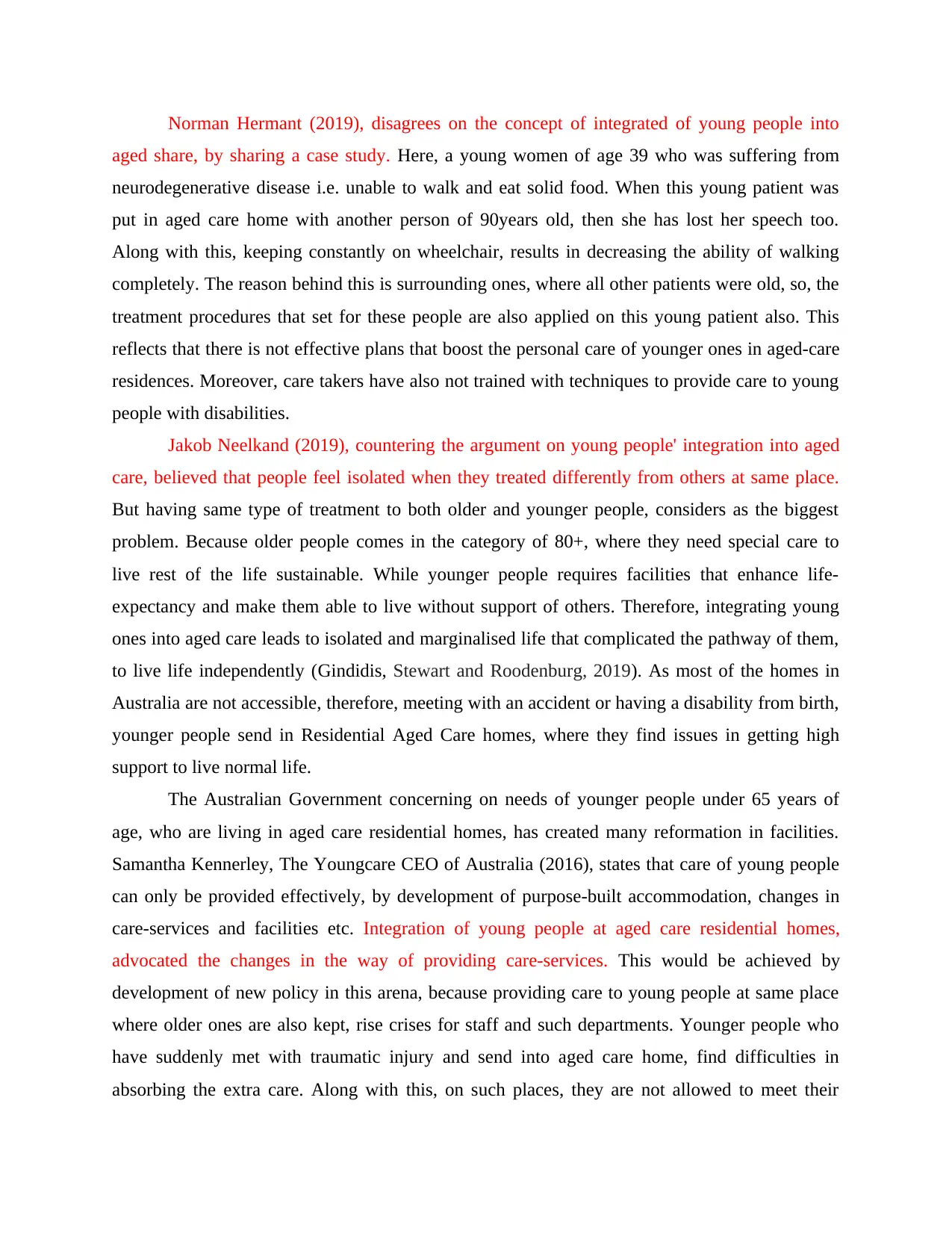
Norman Hermant (2019), disagrees on the concept of integrated of young people into
aged share, by sharing a case study. Here, a young women of age 39 who was suffering from
neurodegenerative disease i.e. unable to walk and eat solid food. When this young patient was
put in aged care home with another person of 90years old, then she has lost her speech too.
Along with this, keeping constantly on wheelchair, results in decreasing the ability of walking
completely. The reason behind this is surrounding ones, where all other patients were old, so, the
treatment procedures that set for these people are also applied on this young patient also. This
reflects that there is not effective plans that boost the personal care of younger ones in aged-care
residences. Moreover, care takers have also not trained with techniques to provide care to young
people with disabilities.
Jakob Neelkand (2019), countering the argument on young people' integration into aged
care, believed that people feel isolated when they treated differently from others at same place.
But having same type of treatment to both older and younger people, considers as the biggest
problem. Because older people comes in the category of 80+, where they need special care to
live rest of the life sustainable. While younger people requires facilities that enhance life-
expectancy and make them able to live without support of others. Therefore, integrating young
ones into aged care leads to isolated and marginalised life that complicated the pathway of them,
to live life independently (Gindidis, Stewart and Roodenburg, 2019). As most of the homes in
Australia are not accessible, therefore, meeting with an accident or having a disability from birth,
younger people send in Residential Aged Care homes, where they find issues in getting high
support to live normal life.
The Australian Government concerning on needs of younger people under 65 years of
age, who are living in aged care residential homes, has created many reformation in facilities.
Samantha Kennerley, The Youngcare CEO of Australia (2016), states that care of young people
can only be provided effectively, by development of purpose-built accommodation, changes in
care-services and facilities etc. Integration of young people at aged care residential homes,
advocated the changes in the way of providing care-services. This would be achieved by
development of new policy in this arena, because providing care to young people at same place
where older ones are also kept, rise crises for staff and such departments. Younger people who
have suddenly met with traumatic injury and send into aged care home, find difficulties in
absorbing the extra care. Along with this, on such places, they are not allowed to meet their
aged share, by sharing a case study. Here, a young women of age 39 who was suffering from
neurodegenerative disease i.e. unable to walk and eat solid food. When this young patient was
put in aged care home with another person of 90years old, then she has lost her speech too.
Along with this, keeping constantly on wheelchair, results in decreasing the ability of walking
completely. The reason behind this is surrounding ones, where all other patients were old, so, the
treatment procedures that set for these people are also applied on this young patient also. This
reflects that there is not effective plans that boost the personal care of younger ones in aged-care
residences. Moreover, care takers have also not trained with techniques to provide care to young
people with disabilities.
Jakob Neelkand (2019), countering the argument on young people' integration into aged
care, believed that people feel isolated when they treated differently from others at same place.
But having same type of treatment to both older and younger people, considers as the biggest
problem. Because older people comes in the category of 80+, where they need special care to
live rest of the life sustainable. While younger people requires facilities that enhance life-
expectancy and make them able to live without support of others. Therefore, integrating young
ones into aged care leads to isolated and marginalised life that complicated the pathway of them,
to live life independently (Gindidis, Stewart and Roodenburg, 2019). As most of the homes in
Australia are not accessible, therefore, meeting with an accident or having a disability from birth,
younger people send in Residential Aged Care homes, where they find issues in getting high
support to live normal life.
The Australian Government concerning on needs of younger people under 65 years of
age, who are living in aged care residential homes, has created many reformation in facilities.
Samantha Kennerley, The Youngcare CEO of Australia (2016), states that care of young people
can only be provided effectively, by development of purpose-built accommodation, changes in
care-services and facilities etc. Integration of young people at aged care residential homes,
advocated the changes in the way of providing care-services. This would be achieved by
development of new policy in this arena, because providing care to young people at same place
where older ones are also kept, rise crises for staff and such departments. Younger people who
have suddenly met with traumatic injury and send into aged care home, find difficulties in
absorbing the extra care. Along with this, on such places, they are not allowed to meet their
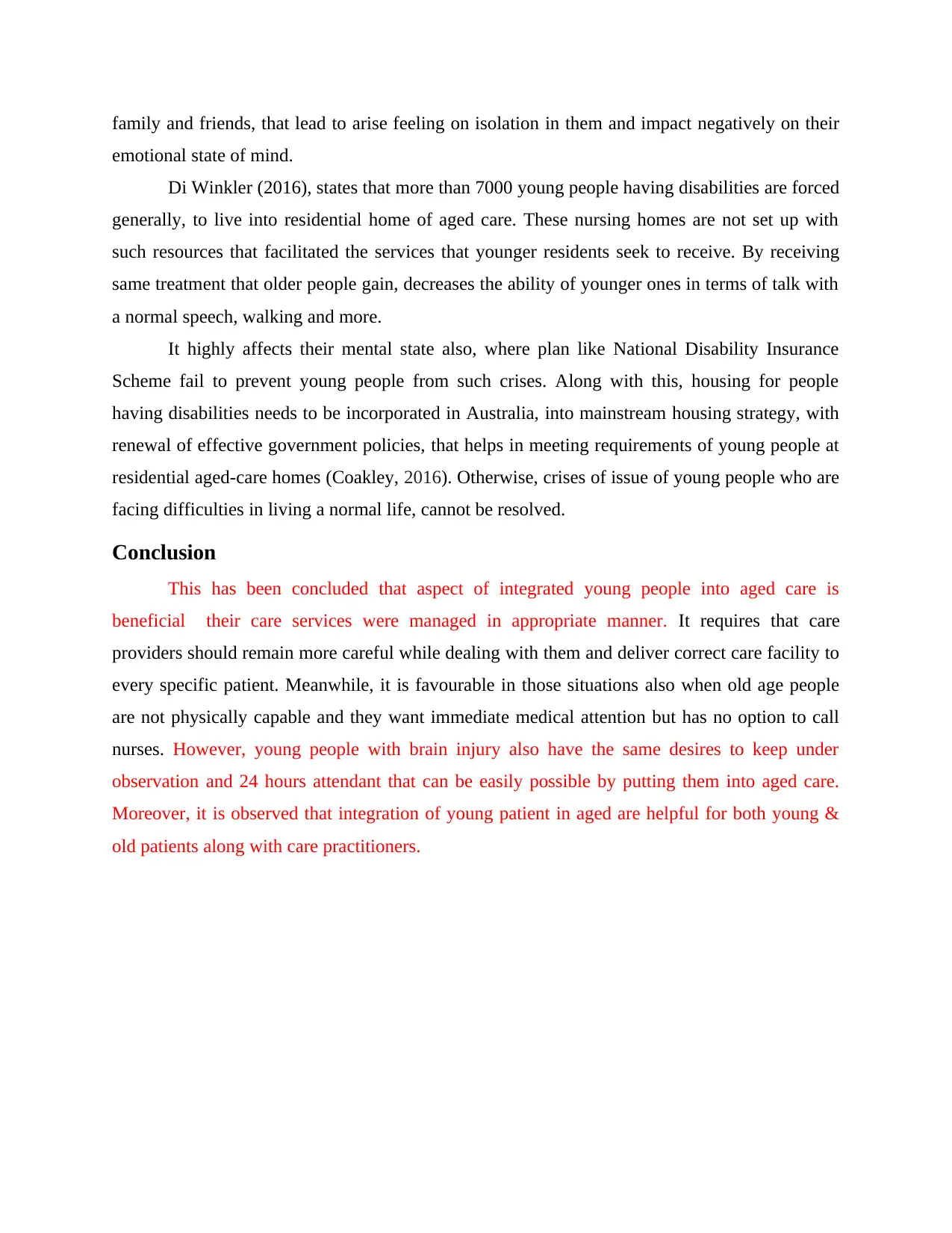
family and friends, that lead to arise feeling on isolation in them and impact negatively on their
emotional state of mind.
Di Winkler (2016), states that more than 7000 young people having disabilities are forced
generally, to live into residential home of aged care. These nursing homes are not set up with
such resources that facilitated the services that younger residents seek to receive. By receiving
same treatment that older people gain, decreases the ability of younger ones in terms of talk with
a normal speech, walking and more.
It highly affects their mental state also, where plan like National Disability Insurance
Scheme fail to prevent young people from such crises. Along with this, housing for people
having disabilities needs to be incorporated in Australia, into mainstream housing strategy, with
renewal of effective government policies, that helps in meeting requirements of young people at
residential aged-care homes (Coakley, 2016). Otherwise, crises of issue of young people who are
facing difficulties in living a normal life, cannot be resolved.
Conclusion
This has been concluded that aspect of integrated young people into aged care is
beneficial their care services were managed in appropriate manner. It requires that care
providers should remain more careful while dealing with them and deliver correct care facility to
every specific patient. Meanwhile, it is favourable in those situations also when old age people
are not physically capable and they want immediate medical attention but has no option to call
nurses. However, young people with brain injury also have the same desires to keep under
observation and 24 hours attendant that can be easily possible by putting them into aged care.
Moreover, it is observed that integration of young patient in aged are helpful for both young &
old patients along with care practitioners.
emotional state of mind.
Di Winkler (2016), states that more than 7000 young people having disabilities are forced
generally, to live into residential home of aged care. These nursing homes are not set up with
such resources that facilitated the services that younger residents seek to receive. By receiving
same treatment that older people gain, decreases the ability of younger ones in terms of talk with
a normal speech, walking and more.
It highly affects their mental state also, where plan like National Disability Insurance
Scheme fail to prevent young people from such crises. Along with this, housing for people
having disabilities needs to be incorporated in Australia, into mainstream housing strategy, with
renewal of effective government policies, that helps in meeting requirements of young people at
residential aged-care homes (Coakley, 2016). Otherwise, crises of issue of young people who are
facing difficulties in living a normal life, cannot be resolved.
Conclusion
This has been concluded that aspect of integrated young people into aged care is
beneficial their care services were managed in appropriate manner. It requires that care
providers should remain more careful while dealing with them and deliver correct care facility to
every specific patient. Meanwhile, it is favourable in those situations also when old age people
are not physically capable and they want immediate medical attention but has no option to call
nurses. However, young people with brain injury also have the same desires to keep under
observation and 24 hours attendant that can be easily possible by putting them into aged care.
Moreover, it is observed that integration of young patient in aged are helpful for both young &
old patients along with care practitioners.
⊘ This is a preview!⊘
Do you want full access?
Subscribe today to unlock all pages.

Trusted by 1+ million students worldwide
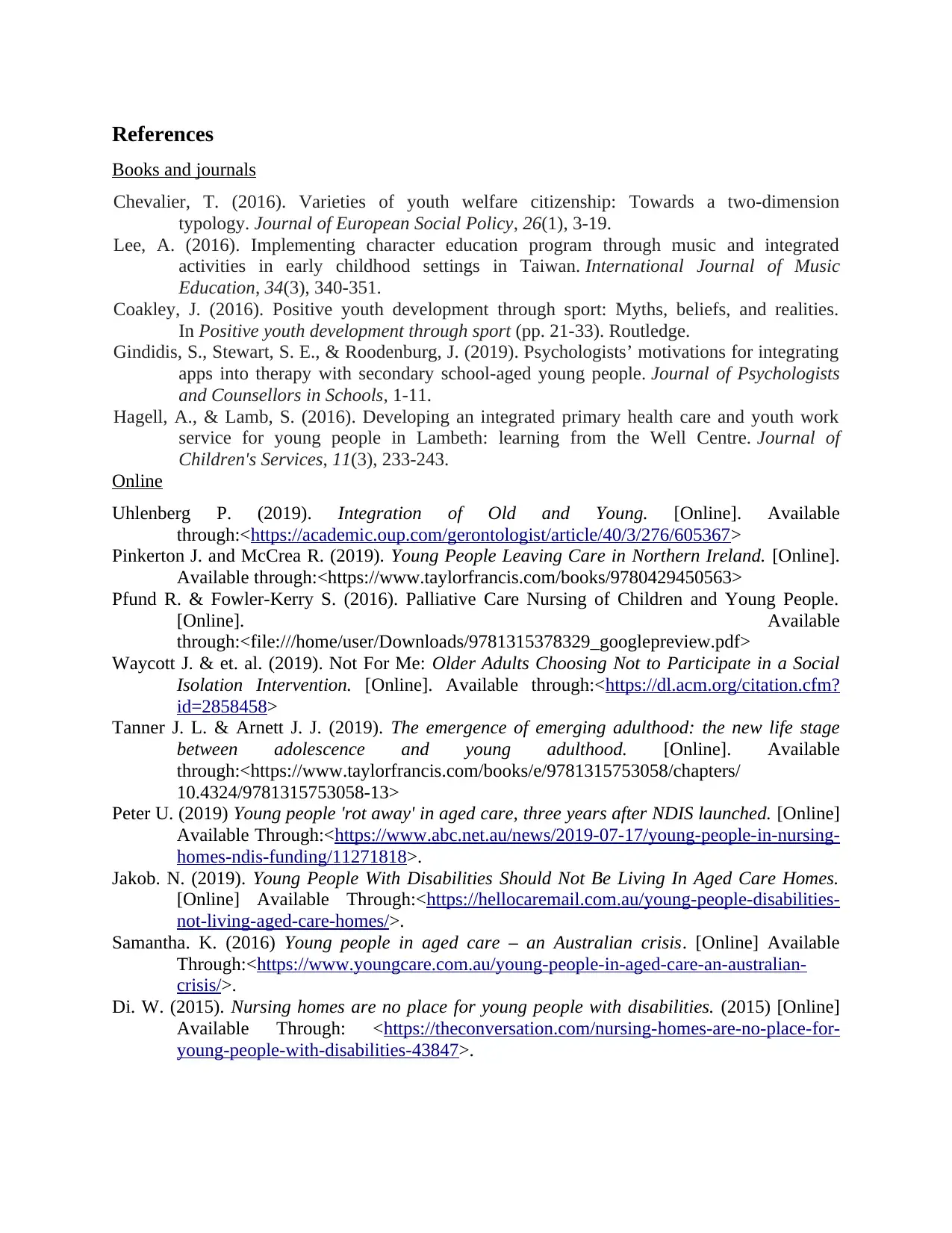
References
Books and journals
Chevalier, T. (2016). Varieties of youth welfare citizenship: Towards a two-dimension
typology. Journal of European Social Policy, 26(1), 3-19.
Lee, A. (2016). Implementing character education program through music and integrated
activities in early childhood settings in Taiwan. International Journal of Music
Education, 34(3), 340-351.
Coakley, J. (2016). Positive youth development through sport: Myths, beliefs, and realities.
In Positive youth development through sport (pp. 21-33). Routledge.
Gindidis, S., Stewart, S. E., & Roodenburg, J. (2019). Psychologists’ motivations for integrating
apps into therapy with secondary school-aged young people. Journal of Psychologists
and Counsellors in Schools, 1-11.
Hagell, A., & Lamb, S. (2016). Developing an integrated primary health care and youth work
service for young people in Lambeth: learning from the Well Centre. Journal of
Children's Services, 11(3), 233-243.
Online
Uhlenberg P. (2019). Integration of Old and Young. [Online]. Available
through:<https://academic.oup.com/gerontologist/article/40/3/276/605367>
Pinkerton J. and McCrea R. (2019). Young People Leaving Care in Northern Ireland. [Online].
Available through:<https://www.taylorfrancis.com/books/9780429450563>
Pfund R. & Fowler-Kerry S. (2016). Palliative Care Nursing of Children and Young People.
[Online]. Available
through:<file:///home/user/Downloads/9781315378329_googlepreview.pdf>
Waycott J. & et. al. (2019). Not For Me: Older Adults Choosing Not to Participate in a Social
Isolation Intervention. [Online]. Available through:<https://dl.acm.org/citation.cfm?
id=2858458>
Tanner J. L. & Arnett J. J. (2019). The emergence of emerging adulthood: the new life stage
between adolescence and young adulthood. [Online]. Available
through:<https://www.taylorfrancis.com/books/e/9781315753058/chapters/
10.4324/9781315753058-13>
Peter U. (2019) Young people 'rot away' in aged care, three years after NDIS launched. [Online]
Available Through:<https://www.abc.net.au/news/2019-07-17/young-people-in-nursing-
homes-ndis-funding/11271818>.
Jakob. N. (2019). Young People With Disabilities Should Not Be Living In Aged Care Homes.
[Online] Available Through:<https://hellocaremail.com.au/young-people-disabilities-
not-living-aged-care-homes/>.
Samantha. K. (2016) Young people in aged care – an Australian crisis. [Online] Available
Through:<https://www.youngcare.com.au/young-people-in-aged-care-an-australian-
crisis/>.
Di. W. (2015). Nursing homes are no place for young people with disabilities. (2015) [Online]
Available Through: <https://theconversation.com/nursing-homes-are-no-place-for-
young-people-with-disabilities-43847>.
Books and journals
Chevalier, T. (2016). Varieties of youth welfare citizenship: Towards a two-dimension
typology. Journal of European Social Policy, 26(1), 3-19.
Lee, A. (2016). Implementing character education program through music and integrated
activities in early childhood settings in Taiwan. International Journal of Music
Education, 34(3), 340-351.
Coakley, J. (2016). Positive youth development through sport: Myths, beliefs, and realities.
In Positive youth development through sport (pp. 21-33). Routledge.
Gindidis, S., Stewart, S. E., & Roodenburg, J. (2019). Psychologists’ motivations for integrating
apps into therapy with secondary school-aged young people. Journal of Psychologists
and Counsellors in Schools, 1-11.
Hagell, A., & Lamb, S. (2016). Developing an integrated primary health care and youth work
service for young people in Lambeth: learning from the Well Centre. Journal of
Children's Services, 11(3), 233-243.
Online
Uhlenberg P. (2019). Integration of Old and Young. [Online]. Available
through:<https://academic.oup.com/gerontologist/article/40/3/276/605367>
Pinkerton J. and McCrea R. (2019). Young People Leaving Care in Northern Ireland. [Online].
Available through:<https://www.taylorfrancis.com/books/9780429450563>
Pfund R. & Fowler-Kerry S. (2016). Palliative Care Nursing of Children and Young People.
[Online]. Available
through:<file:///home/user/Downloads/9781315378329_googlepreview.pdf>
Waycott J. & et. al. (2019). Not For Me: Older Adults Choosing Not to Participate in a Social
Isolation Intervention. [Online]. Available through:<https://dl.acm.org/citation.cfm?
id=2858458>
Tanner J. L. & Arnett J. J. (2019). The emergence of emerging adulthood: the new life stage
between adolescence and young adulthood. [Online]. Available
through:<https://www.taylorfrancis.com/books/e/9781315753058/chapters/
10.4324/9781315753058-13>
Peter U. (2019) Young people 'rot away' in aged care, three years after NDIS launched. [Online]
Available Through:<https://www.abc.net.au/news/2019-07-17/young-people-in-nursing-
homes-ndis-funding/11271818>.
Jakob. N. (2019). Young People With Disabilities Should Not Be Living In Aged Care Homes.
[Online] Available Through:<https://hellocaremail.com.au/young-people-disabilities-
not-living-aged-care-homes/>.
Samantha. K. (2016) Young people in aged care – an Australian crisis. [Online] Available
Through:<https://www.youngcare.com.au/young-people-in-aged-care-an-australian-
crisis/>.
Di. W. (2015). Nursing homes are no place for young people with disabilities. (2015) [Online]
Available Through: <https://theconversation.com/nursing-homes-are-no-place-for-
young-people-with-disabilities-43847>.
1 out of 7
Related Documents
Your All-in-One AI-Powered Toolkit for Academic Success.
+13062052269
info@desklib.com
Available 24*7 on WhatsApp / Email
![[object Object]](/_next/static/media/star-bottom.7253800d.svg)
Unlock your academic potential
Copyright © 2020–2025 A2Z Services. All Rights Reserved. Developed and managed by ZUCOL.





